The Intel Haswell Refresh Review: Core i7-4790, i5-4690 and i3-4360 Tested
by Ian Cutress on May 11, 2014 3:01 AM ESTReal World Benchmarks
2D to 3D Rendering –Agisoft PhotoScan v1.0: link
Agisoft Photoscan creates 3D models from 2D images, a process which is very computationally expensive. The algorithm is split into four distinct phases, and different phases of the model reconstruction require either fast memory, fast IPC, more cores, or even OpenCL compute devices to hand. Agisoft supplied us with a special version of the software to script the process, where we take 50 images of a stately home and convert it into a medium quality model. This benchmark typically takes around 15-20 minutes on a high end PC on the CPU alone, with GPUs reducing the time.
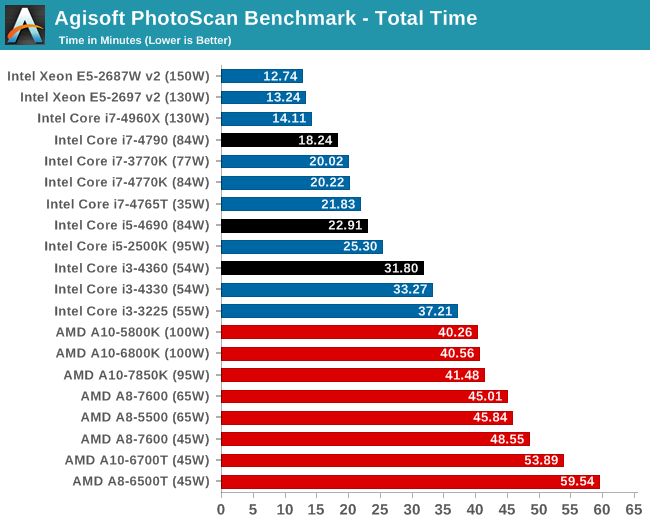
For Photoscan we see the incremental speedup with the i3 models, but the increased single thread speed of the i7 makes more of a difference.
Compression – WinRAR 5.0.1: link
Our WinRAR test from 2013 is updated to the latest version of WinRAR at the start of 2014. We compress a set of 2867 files across 320 folders totaling 1.52 GB in size – 95% of these files are small typical website files, and the rest (90% of the size) are small 30 second 720p videos.
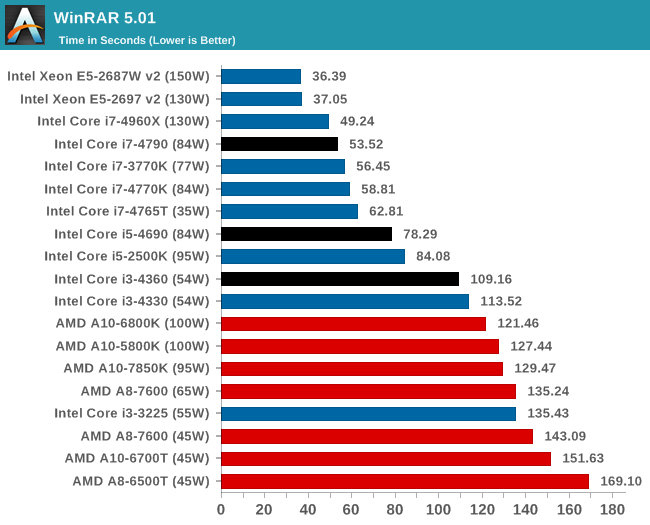
For WinRAR, the increase in the threads makes the most difference here, moving from i5-4690 to i7-4675T.
Image Manipulation – FastStone Image Viewer 4.9: link
Similarly to WinRAR, the FastStone test us updated for 2014 to the latest version. FastStone is the program I use to perform quick or bulk actions on images, such as resizing, adjusting for color and cropping. In our test we take a series of 170 images in various sizes and formats and convert them all into 640x480 .gif files, maintaining the aspect ratio. FastStone does not use multithreading for this test, and thus single threaded performance is often the winner.
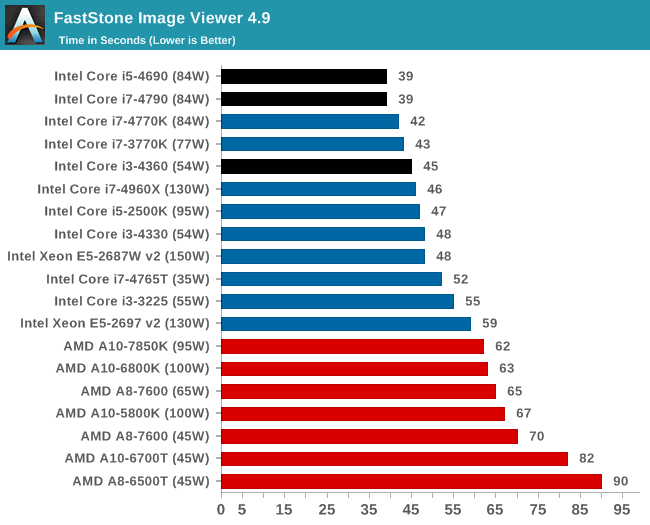
FastStone is all about the single thread speed.
Video Conversion – Xilisoft Video Converter 7: link
The XVC test I normally do is updated to the full version of the software, and this time a different test as well. Here we take two different videos: a double UHD (3840x4320) clip of 10 minutes and a 640x266 DVD rip of a 2h20 film and convert both to iPod suitable formats. The reasoning here is simple – when frames are small enough to fit into memory, the algorithm has more chance to apply work between threads and process the video quicker. Results shown are in seconds and time taken to encode.
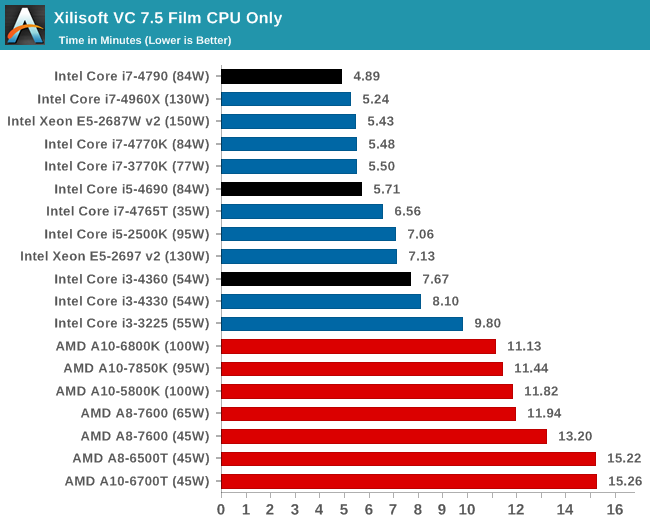
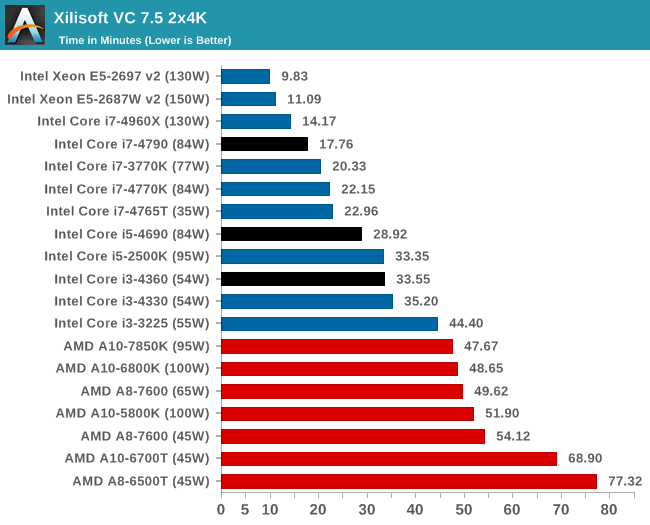
Small frames prefer more single thread MHz, whereas the dual 4K frame conversion prefers threads.
Video Conversion – Handbrake v0.9.9: link
Handbrake is a media conversion tool that was initially designed to help DVD ISOs and Video CDs into more common video formats. The principle today is still the same, primarily as an output for H.264 + AAC/MP3 audio within an MKV container. In our test we use the same videos as in the Xilisoft test, and results are given in frames per second.
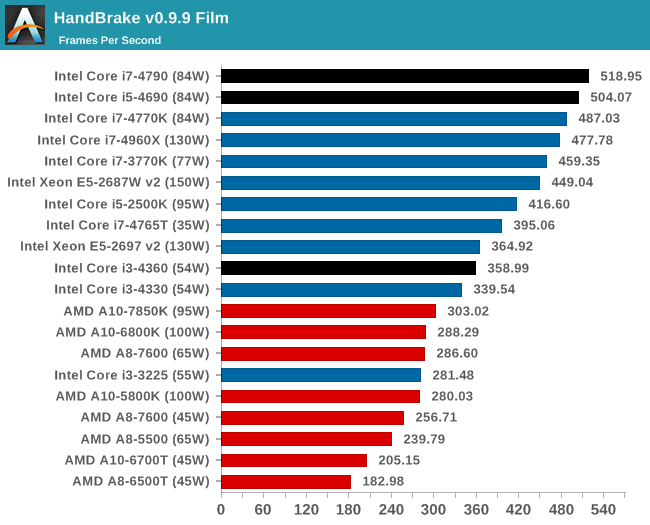
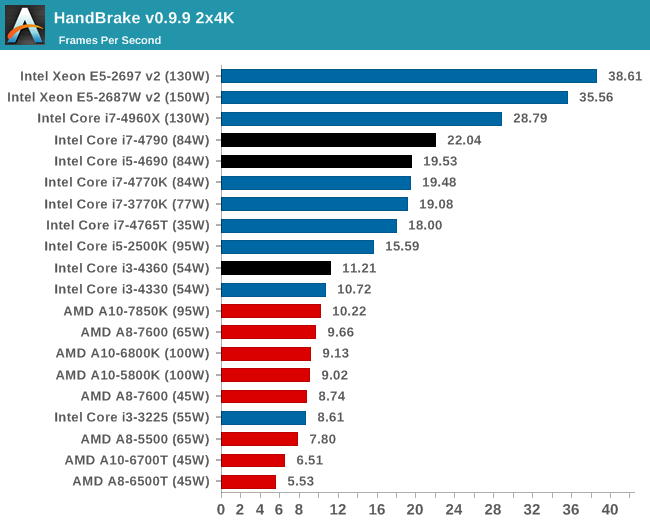
With Handbrake it would seem that it prefers actual cores rather than hyperthreading, given by the i5 and i7 being relatively close and 2x the i3.










130 Comments
View All Comments
rajod1 - Thursday, May 29, 2014 - link
I agree, waste of cash to upgrade every generation. Old days were nice. Intel said they would hit 10 GHZ by like 2004 or something. LOL. So they hit a wall but still needed cash. Lots of suckers born every minute that will upgrade for 10 percent increase.Hrel - Monday, May 12, 2014 - link
The fact that hyperthreading is disabled on the i5's on the desktop is infuriating. Enabling it costs them nothing. Agree on the 8 core at $300, it should still have HT though.Flunk - Monday, May 12, 2014 - link
Definitely, turn on HT on i5 and give them all 4 cores and offer an 8 core i7 with HT. i3s can soldier on with only 2 cores if they really want to.A i7 5770 with 8 cores and HT is what they really need to bring out, but I think they're waiting for AMD to bring out something better first.
rajod1 - Friday, May 30, 2014 - link
You may as well ask them to drop the I5 because if you put HT on a I5 its then I7.rajod1 - Friday, May 30, 2014 - link
It does cost them something. They sell my I7s that way.bsim500 - Sunday, May 11, 2014 - link
Thanks for this review - appreciate the effort that went into it as always."Also of note is the Z97 motherboard we used for these tests implements an Adaptive voltage profile, meaning that artificial loads such as OCCT push the voltage higher than normal, increasing power consumption at load"
So they've still got that dumb Haswell "feature" of stuffing the Vcore up by +0.1v when you least want it? Also why are your power consumption figures so high in general? My i5-3570 @ 4.0Ghz barely pulls 37w idle / 88w 4-threads prime with a 7870 discrete card (whole system (excluding monitor) measured at the wall). That's roughly 25w lower both idle & load than your i3 (with a 1600MHz idle vs 800Mhz Haswell's)! Just out of curiosity, what where the stock / default VID's like on the i3-4360 / i5-4690? ie, has the clock speed bump increased required voltages much? Thanks.
Ian Cutress - Sunday, May 11, 2014 - link
Adaptive is an Intel specification implementation, but for some reason goes haywire with certain 100% load simulators (OCCT/AIDA).With regards power consumption seeming high:
a) Low efficiency band of the PSU. Hence me stating qualitative analysis more relevant than quantitative. Need to keep the PSU consistent across all the tests, some tests require 2x/3x GPUs (e.g. X79). This is probably a large part of it, but all tests are therefore done on the same efficiency curve.
b) Using a Corsair H80i with two fans and ODD plugged in. I move the USB devices to USB 2.0 so any USB 3.0 controller can power down, but it still all adds up.
c) OCCT loading does the adaptive voltage thing, causing more power consumption at load from idle.
We got ES chips to test, so retail might have adjusted slightly on the stock VID. Also VID can differ from chip to chip in the same bin, so it's not really a good measure. One CPU can have a high VID in the bin, while the next bin up we could get a low VID, and it all look a bit odd.
Daniel Egger - Sunday, May 11, 2014 - link
IMNSHO it is really ridiculous to test all systems with the same outlandish special PSUs that no sane person would ever use. Why not have a testbed for single card systems with say a platinum 500W PSU (which should cover even the nasty R295X2 plus a Haswell K processor) and a separate one for crazy setups? With those far sub 20% loads even under full load it is nearly impossible to get useful readings not to mention comparable ones since at these low loads lots of funny effects kick in skewing the results...wetwareinterface - Sunday, May 11, 2014 - link
The reason you don't have a low end psu on your test bench is it's a test bench.The one setup should handle anything you can possibly throw at it and then a little extra for good measure.
Also having the exact same high wattage psu to test everything on eliminates the psu as a differentiating factor when testing multiple system configurations.
and finally the sad truth is there are several reviewers working for anandtech each from home and each with whatever they have laying around to do said testing with...
Daniel Egger - Monday, May 12, 2014 - link
> The reason you don't have a low end psu on your test bench is it's a test bench.The one setup should handle anything you can possibly throw at it and then a little extra for good measure.
Exactly my point for suggesting a 500W PSU rather than something much lower that I would personally put into a build. That should be sufficient for any even just halfway reasonable setup.
> Also having the exact same high wattage psu to test everything on eliminates the psu as a differentiating factor when testing multiple system configurations.
Unfortunately that's not true. Very low output on high wattage PSUs skews the results quite a bit because they typically are not accurate enough when it comes to handling the low loads thus smearing over the results with their own losses. I assume this is also why our Greek friend here doesn't even bother to test loads below 5% (which would be 60W at a 1200W PSU, about twice as much as my current Haswell PC needs on an mostly Idle Windows desktop).